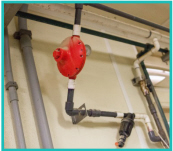



How to Troubleshoot Water Delivery Systems
Tip on the maintenance of drinking systems for pigs from Tom Guthrie of Michigan State University Extension in the 'How-To' series from Pork Information Gateway.Importance of Water
Water can be viewed as the central nutrient and is one of the most important and essential nutrients required by pigs.
Many factors such as source of water, estimated water requirements, flow rate recommendations, drinking spaces, number of drinkers, water supply and water quality should be considered when evaluating water delivery systems for swine. In addition to animal consumption, swine farms also use water as a resource for cleaning facilities, animal cooling and in some instances for moving manure from the barn to the storage structure. Therefore, it is imperative that water delivery systems are in excellent working condition.
In many cases, the universal problem with water delivery systems is inadequate flow. When attempting to troubleshoot water delivery systems in swine facilities it may be best to take a systematic approach in an effort to identify the deficiency.
Water delivery systems can be broken down into three general categories including:
- individual drinking device
- water distribution within building/room(s) and
- farm distribution.

Individual Drinking Device
Common problem: water flow rate (inadequate or too much)
Checking flow rates of individual drinking devices gives a quick assessment if water is available to pigs.
Table 1 illustrates recommended flow rates for drinking devices in swine facilities by class of pig. Flow rate can be easily and efficiently checked by utilising a plastic measuring cup. If flow rate is four cups per minute then it should take only 15 seconds to fill one cup. It is important to check flow rate at both low and high water use times.

Diagnosing the problem:
- Make sure of appropriate drinking device for age class of pig and water delivery system (low pressure system vs. high pressure drinkers, etc.)
- Ensure drinking devices are accessible to all pigs in the pen:
- appropriate height, easily accessed
- Examine drinking devices
- Parts of a drinking device (Figure 1)
- Check screen on back of drinking device to verify screen is free of debris (Figure 2)
- Use correct hole setting to achieve desired flow rate (Figure 3)

Water Distribution within Buildings or Rooms
Associated problems: No water, low water pressure, reduction of internal diameter and/or insufficient diameter of supply pipe
Diagnosing the problem:
- Verify water pressure via meters or gauges (Illustration 4)
- No water - check to verify water source to specific room is turned on

- Low water pressure – may be due simultaneous water resource uses (cleaning, etc.)
- Reduction of internal diameter – possibly due to rust, mineral sedimentation, iron bacteria build-up and/or possibly algae inside the supply line
- Water medicator attachments: be sure water medicators are equipped with appropriately sized attachments to water supply lines. If the swine facility has a supply line that is larger than the medicator attachment, the flow of water will be reduced at the point of the medicator attachment
- Consider diameter of supply line: if the supply line is incapable of delivering appropriate gallons per minute, there is a chance that one or more drinkers would have reduced flow or even no flow when a pig attempts to drink. (Brumm 2010).

Possible Problem: Inadequate Water Pressure
Diagnosing the problem
- It is important to know where the main water supply shut off valve is located
- Consider times of peak water demand and other water resource uses, overstretched water supplies can contribute to overall farm water pressure problems (Figure 5)
- If facility is equipped with a pressure tank or holding tank, evaluate size, location of tank and capability of tank to function in regard to expected water delivery performance
- Evaluate all possible components associated with the respective water delivery system which may include: filters, floats, lids of tanks, ball valves, line valves, water filtration system, meters, etc.

Maintenance Programme
Implementing a basic maintenance programme, including checking flow rates and filters prior to the introduction of new animals in the barn and through daily observations, is beneficial to ensure pigs are receiving an adequate water supply.
Starting at the pig drinking device and following the water lines back through the water delivery system is also helpful in identifying points of interest that may need to be addressed in a swine water system delivery maintenance programme.
References
- Brumm, M. 2010. Water Recommendations and Systems for Swine. National Swine Nutrition Guide. PIG 07-02-08.
- Carr, J. 2003. Water Systems - Troubleshooting common mistakes. ThePigSite.com. 29 September 2003.
- Guthrie, T. 2005. Water management in swine facilities. MSU Pork Quarterly. 10 (3):5-9.
- Midwest Plan Service. 1983. Swine housing and equipment handbook. Publication no. MWPS-8. Iowa State University, Ames, IA
- Thacker, P.A. 2001. Water in Swine Nutrition. In: Lewis A.J., Southern L.L. editors. Swine Nutrition, 2nd Ed. Boca Raton: CRC Press. p381-398.
April 2015








